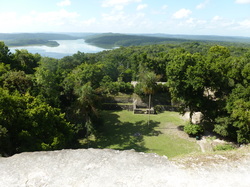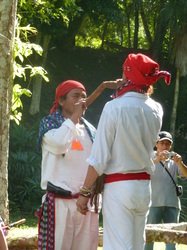
from Flores, Guatamala! I’m writing from a lakeview apartment, where I watch the fishermen cross the water in their thin blue and pink boats.
I am close to some of Petén’s jungle, the most extensive remaining
tropical rainforest in Central America.
Three days ago I finished my second tour , Winter Solstice in Petén. I had
two adventuresome and seasoned travelers with me, which was a delight. It’s not that the tour was an “adventure tour” in the usual sense of hiking, splunking and mountain biking over rugged terrain. Still, the land of the Maya is always an adventure, full of synchronicity, fluidity and the unexpected. And then
there’s the simple adventure of climbing stairs to astonishing heights.

profoundly peaceful experience,to be so high up and securely seated on these countless blocks of
limestone which were cut and placed with unworldly precision. Below us were the crocodile infested quarries where it was said the stones was cut. (Crocodiles are understandably prominent in Mayan cosmology). We walked on the same roads the Maya used to haul stone and to walk their kingdoms.

sun rises in different locations in marking these passages. Also, being at Uaxactún when there are no other visitors, which has been my experience several times now, allows space to experience the natural mysticism of this astonishing location . Despite their magnificence, the appearance of these massive buildings is misleading. In fact, during their occupation by the
Maya these same buildings were painted in reds, blues, yellows, greens, as so
many houses are still painted in Guatemala today. But it was hard to color the sites in my mind, they are so large and so completely the color of their stones.


of the tour was the two rituals we were able to experience.
We stayed overnight in Uaxactún, where Naría led us in a cooking class
and taught us a bit about healing swollen mosquito bites with natural
herbs. As in many other towns in Latin America, Uaxactún was having a series of posadas, where each night an altar of Mary and Joseph is paraded through town with candles and singing, with the procession ending at a prearranged house. Happily, on the night we were there, the procession ended at Naria’s.
She had made a huge pot of hot chocolate with cinnamon and had slices of
cake to welcome to procession. The altar was simple, decorated with palms and thatch, with paper mache figures of Joseph and Mary inside. The group came by candlelight and flashlight, making their way through the dark to Naria’s. Outside the door, the group sang in Spanish telling the story of Jesus and Mary looking for lodging. Inside the group responded that yes, they would open their doors to house this poor couple in need. It was very touching to see this drama enacted in Uaxactún: the poor pregnant couple seeking aid and the poor stable owner making room for them in this small town of people living in poverty themselves.

were invited to join the winter solstice ceremonies of the Unification
Maya. This is a group of
Guatemalan spiritual leaders who believe that the Maya calendar speaks to the
evolution of humanity. These
shaman (both men and women), accompanied by their western students, led us in ritual at the Tikal site of El Mundo Perdido, (the lost world,) an ancient Maya astronomical site constructed in 500 BC. The 2011 winter solstice fell on the Maya calendar day of Ix, associated with the jaguar, a symbol of feminine
power and of protecting the natural world. Several of the shamans spoke of the need to rebalance female and male
energies so that feminine traits of protecting life were once honored. Women called the directions for the ritual and were actively involved in the ceremony. I was moved to tears when one of the shaman said that in the past, they had thought only within the realm of heterosexual relations, but as they had learned more about the 10% of the world's gay and lesbian population, they had revised their own understanding in line with their belief that Maya wisdom honors all people. In Guatemala, a country known for its homophobia, this was a revolutionary announcement. The protection of diversity – both of peoples and of the natural world --was frequently invoked in the ceremony. We were invited to join in meditations of purification and empowerment, and were given seeds and candles to throw into the fire as the ceremony acknowledged the strengths of each of the 20 Mayan day glyphs.
21, 2012. The Maya long count calendar is based on detailed study of the alignment of the Milky Way with the earth. The following year will see the earth aligned with the center of the Milky Way and is said to provide new energies to the planet. There is as much debate about the significance of this among the Maya I have spoken with as there is in the larger world.
Yet one thing has been constant in the information I have received here -- the calendar itself does not end but starts a new cycle. And also there is no evidence that the calendar predicts the end of the world. At the same time, the spiritual leaders
and other Maya I have spoken with agree that there is an urgent need to end the contamination of the planet by industry, war and discrimination. Many believe that this date heralds a time of radically shifting priorities and the emergence of a consciousness of unity greater than we have known in the past. It was a very beautiful and moving experience to sit at the base of these great towering structures and reflect upon the heart of time, the passages that bring us together and the astonishing natural beauty of Petén, Guatemala.









 RSS Feed
RSS Feed

